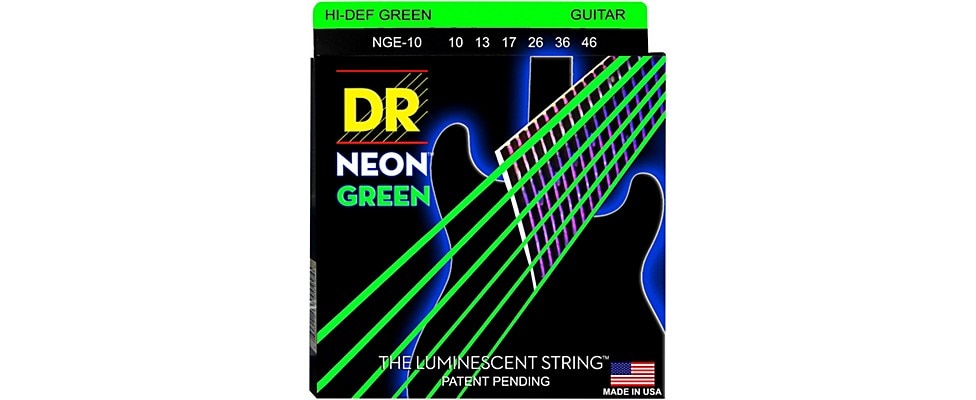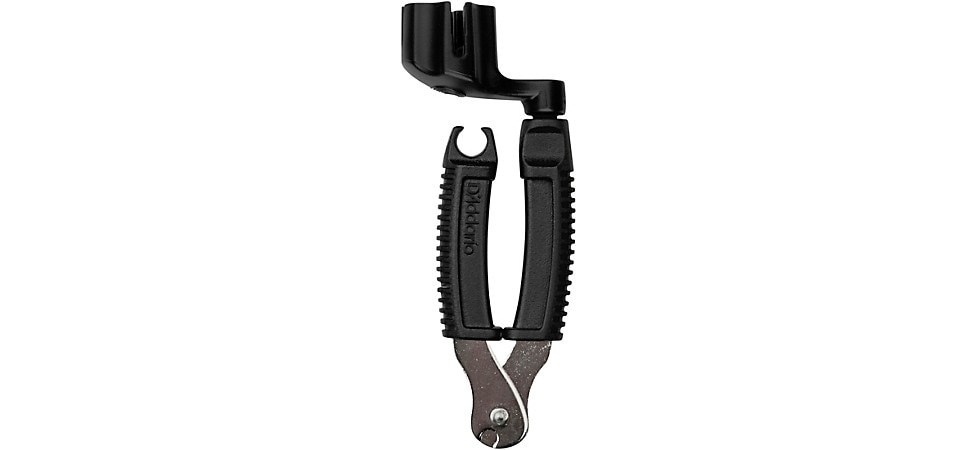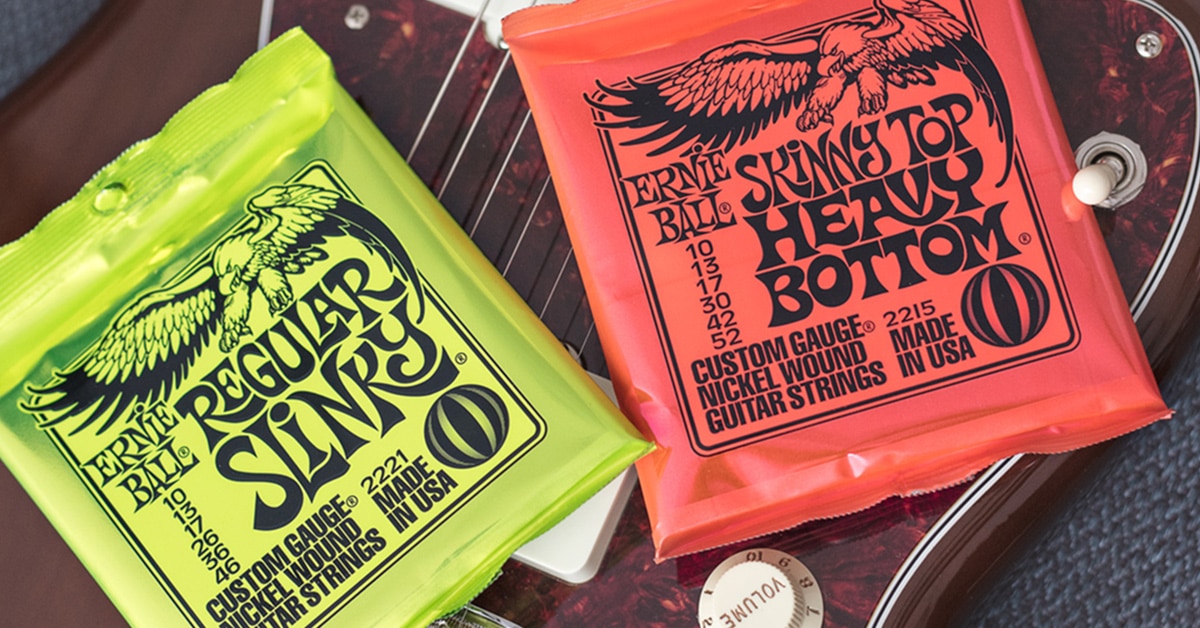The strings on your electric guitar have a major impact on its sound and playability. If you’ve taken a look at the huge Musician’s Friend guitar string assortment, you’ve likely realized that there’s a lot to consider in figuring out which strings are right for you and your electric guitar. Keep reading to find the strings that best match your electric guitar, music, and playing style.
Need help buying the best acoustic guitar strings? Check out our Acoustic Guitar String Buying Guide.
Table of Contents
Electric Guitar String Gauges
Electric Guitar String Set Gauge Designations
Factors to Consider When Shopping for Electric Guitar Strings
String Gauge Playing Characteristics
String Durability
Electric Guitar String Construction Materials
Types of String Windings
Signs That it’s Time to Change Your Guitar Strings
How Often Should Electric Guitar Strings be Changed?
Electic Guitar String Maintenance Tips
Electric Guitar String Gauges
Electric guitar strings are manufactured in a range of thicknesses or gauges. These gauges are designated in thousandths of an inch. The lightest strings are typically an .008 (often referred to by guitarists as “eights”) and the heaviest a .56 (or fifty-six). String gauge has a big influence on playability and sound.
Lighter gauge electric guitar strings:
- Are generally easier to play
- Allow easier bending of notes and fretting
- Break more easily
- Produce less volume and sustain
- Are prone to cause fret buzzing, especially on guitars with low action
- Exert less tension on the guitar neck and are a safe choice for vintage guitars
Heavier gauge electric guitar strings:
- Are generally harder to play
- Require more finger pressure to fret and bend notes
- Produce more volume and sustain
- Are preferred for low tunings such as "Drop D"
- Exert more tension on the guitar neck

Ernie Ball's 3221 Slinky strings have a bright, clear sound thanks to their nickel-plated steel winding; the gauges are typical of a “light” set.
String Set Gauge Designations
Most string manufacturers identify the string gauges in a set using terms such as “extra light” or “heavy.” While the exact gauges may vary slightly among manufacturers, here are typical gauge ranges for electric guitar string sets:
Electric Guitar String Set Gauges
String sets are sometimes identified by the gauge of the high E string—the smallest-gauge string. A “medium” set of electric guitar strings for example might be just identified as an “0.11 set”. The table below lists the typical string gauges found in the most popular packs of electric guitar strings.
| String Gauge | High E String | B String | G String | D String | A String | Low E String |
| "Extra Super Light" | .008 | .010 | .015 | .021 | .030 | .038 |
| "Super Light" | .009 | .011 | .016 | .024 | .032 | .042 |
| "Light" | .010 | .013 | .017 | .026 | .036 | .046 |
| "Medium" | .011 | .015 | .018 | .026 | .036 | .050 |
| "Heavy" | .012 | .016 | .020 | .032 | .042 | .054 |
Factors to Consider When Shopping for Electric Guitar Strings
The most important factors to consider in shopping for electric guitar strings are:
- Your playing style and music genre
- How often you play
- The sound character and tone you want to achieve
The things that impact those factors are:
- String gauge
- String construction materials
- Type of string winding method
- Uncoated vs coated string treatments
We’ll next look at each of these variables to come up with the strings most likely to work for you and your guitar.
Electric Guitar String Gauge Playing Characteristics
As we discussed above, lighter strings are easier to play. If you aspire to be a shredder burning up the fretboard with lighting-fast leads and intense rhythm chording, you’ll want to use lighter gauges. That said, if you’re a metal player who uses detuned scales such drop-D tuning, heavier gauges are needed.
Blues and classic rock guitarists who use a lot of string bends often settle on medium gauges that combine reasonably easy bending with more sustain and fatter, richer, darker tone. Mainstream jazz guitarists typically use heavy-gauge flatwound strings since they don’t typically do a lot of note bending and want a broad tone spectrum.

Elixir makes a variety of coated electric guitar strings, including Optiweb, Nanoweb and Polyweb. These strings have a coating on the tops of wound strings and anti-rust plating on plain strings to prolong the life of the entire set.
So, which string gauge is standard for electric guitars? Most new guitars come strung with super-light or light-gauge strings. For beginning guitarists, that’s probably a good place to start. As you develop fretting and picking skills and your fingers gain calluses and strength, you may want to gradually move up to heavier strings, depending on the music you play and the tone you seek. Many guitar manufacturers make specific recommendations about what strings to use. Some produce their own strings or have them custom-manufactured to their specifications.

DR NEONs have bright colored coatings that look great in natural light and glow under black lights.
The key to finding the string gauges that work best for your playing style is experimentation. Try various gauges, brands, and string compositions to find those that feel best to your fingers and are most pleasing to your ears. Differences between various string types can be pretty subtle, but focusing on the nuances of touch and tone can help lead to your own signature sound.
Keep in mind that changing string gauges may require adjustments to your string height or “action” at the bridge saddles, as well as adjustments to the nut and neck. Depending on your skill and the type of electric guitar you own, this may be better left to a guitar tech.
Our friends at Fender walk you through the step-by-step process of changing strings on an electric guitar.
String Durability
Another factor to consider when choosing strings is the frequency with which you play. If you’re an occasional guitarist who plays a few times a month and tend to play with a light touch, you may find less expensive strings perfectly suitable. On the other hand, if you’re devout about practice or play often and hard, premium-grade, heavy-duty strings may prove a better buy in the long run. Many manufacturers grade their strings according to their durability.
Ernie Ball's Paradigm Strings are designed for durability, with an increased tensile strength up to 37% with up to 70% more fatigue strength than a traditional string set.
Electric Guitar String Construction Materials
All electric guitar strings are made using steel, nickel, or other magnetically conductive metal alloys since they’re essential for transmitting string vibrations to the magnetic pickups. The type of plating or coating applied to the steel alloy has a significant impact on the strings’ sound. Here are some general tonal characteristics of the most common types of strings:
- Nickel-Plated Steel: Nickel-Plated steel strings have a balanced brightness and warmth with more attack
- Pure Nickel: Pure Nickel strings are less bright than nickel-plated steel with added warmth
- Stainless Steel: Stainless Steel strings are known for their bright, crisp, “edgy” tone with sustain and corrosion resistance. They are also less prone to finger squeaks
- Chrome: Chrome strings are known for their warmth with less resonance. These strings are often chosen by jazz and blues guitarists
- Titanium: Titanium strings are fairly bright tone with excellent strength
- Cobalt: Cobalt strings have a wide dynamic range with notable brightness and pickup response
- Polymer-coated: Polymer-coated strings provide less sustain than equivalent uncoated strings; corrosion-resistant
- Color-coated: Tonality of color-coated strings varies
D'Addario's XS electric guitar strings are estimated to last 3 to 5 times longer than the average un-coated string.
Types of Electric Guitar String Winding
High E, B, and sometimes G strings are unwound. The other strings have a winding wire wrapped tightly around their cores. The method used to wrap the strings affects both tone and playability as noted below:
- Roundwound: The most popular winding method by far, roundwound strings have a noticeable ridged texture and produce more sustain, attack, and “bite.” They tend to produce more finger noise and fretboard wear
- Halfround: Also called groundround, halfround strings have a smoother texture with darker tone and less attack than roundwounds
- Flatwound: Flatwound strings have a very smooth touch with flat, dark tone that’s less responsive to picking dynamics. These strings are popular with jazz and blues guitarists
Want to learn more about different types of string windings and their impact on feel and tone? Check out our D'Addario Guitar and Bass String Comparison video!
Signs That It’s Time to Change Your Guitar Strings
- Getting in tune and staying in tune is more challenging than usual.
- You’re seeing rust or discoloration on your guitar's strings.
- String wraps are unwinding, exposing the core.
- Your tone sounds “flat” or “dead.”
- You can’t remember the last time you changed strings.
How Often Should Electric Guitar Strings be Changed?
If you've ever found yourself asking, "How often should I change my strings on my electric guitar?", there are some key things to consider. Unfortunately, there is no stock answer for how often you should restring your guitar, but here are a number of factors that would shorten the life of your strings:
- You sweat a lot when playing; your perspiration is acidic.
- You play aggressively with a lot of bending and/or hard picking.
- You play frequently.
- You change tunings frequently.
- You smoke or play in smoky environments.

The Planet Waves Pro-Winder with a built-in cutter makes for fast, easy string changes.
Electic Guitar String Maintenance Tips
- Keep a clean cloth handy and wipe down your strings after every playing session to prolong their life.
- Invest in some specialized cleaning tools to keep your strings and fingerboard in great shape.
- Washing your hands before playing will help prevent string oxidation.
- Invest in a string winder; they’re inexpensive and speed up string changes.
- Note the date you changed strings on the package, then put it in your case to keep track of the age and type of strings you’re using.
- Buying single strings in bulk can be a smart, budget-friendly move, especially where light gauge strings you tend to break more frequently are concerned.
- Keep an extra set and a few high-register single strings in your case for emergency changes that you or a bandmate may need.
After reading this guide, if you’re still unsure which electric guitar strings are right for you, we invite you to call our friendly, knowledgeable Gear Advisers.







































































































































